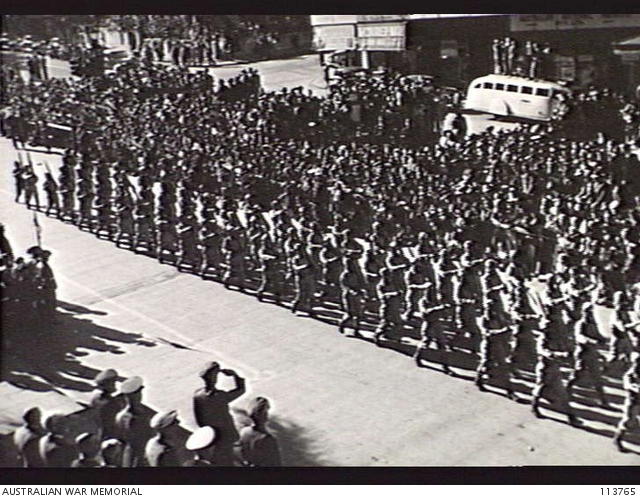Brisbane 16 August 1945. Approximately 10,000 men and women of the fighting services of five nations took part in a victory march through the city streets. The salute was taken by the Governor of Queensland, Sir Leslie Wilson. Shown, the Netherlands East Indies Army contingent passing the saluting base.

Brisbane’s Victory March: 16 August 1945
On 16 August 1945, Brisbane’s city streets came alive as approximately 10,000 men and women from the fighting services of five Allied nations marched in celebration of victory in the Pacific. This grand procession marked the end of hostilities following Japan’s surrender the day before. It was a moment of immense relief and shared pride after years of sacrifice and hardship.
The march was more than just a military parade—it was Brisbane’s public tribute to the Allied forces who had worked together to achieve peace in the region. The salute was taken by the Governor of Queensland, Sir Leslie Wilson, as the troops passed the official dais in front of cheering crowds. The city, which had served as a major Allied headquarters during the war, was draped in flags and banners for the occasion.
The nations that marched together
The march brought together service personnel from five Allied nations:
- Australia, whose forces had borne the brunt of defence and operations across the Pacific
- The United States, whose headquarters for General Douglas MacArthur’s Southwest Pacific command was based in Brisbane
- The Netherlands East Indies (NEI), whose government-in-exile and military forces operated from Brisbane after the Japanese occupation of the Dutch East Indies
- The United Kingdom, represented through units assigned to the Pacific theatre
- New Zealand, whose forces had also contributed to the Allied efforts
The picture above shows the contingent from the Netherlands East Indies Army. Their presence symbolised the deep wartime bond between the Dutch forces and Australia. These troops had found refuge, reorganised, and trained in and around Brisbane—including at Camp Columbia in Wacol, which served as headquarters for the NEI forces and government during their exile. The victory march was a proud moment for these men, many of whom were soon to face the complex challenges of returning to their homeland amid Indonesia’s struggle for independence.
